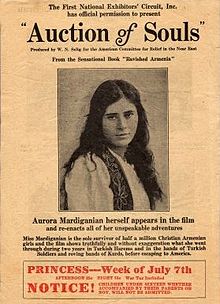Aurora Mardiganian
 From Wikipedia the free encyclopedia
From Wikipedia the free encyclopedia
Aurora Mardiganian | |
|---|---|
 Aurora Mardiganian on a 2013 Armenian stamp | |
| Born | Arshaluys Mardiganian January 12, 1901 |
| Died | February 6, 1994 (aged 93) Los Angeles, California |
| Occupation(s) | Author, actress |
| Notable work | Ravished Armenia (1918) Ravished Armenia (Auction of Souls) (1919) |
Aurora (Arshaluys) Mardiganian (Armenian: Աուրորա [Արշալոյս] Մարտիկանեան; January 12, 1901 – February 6, 1994) was an Armenian-American author, actress, and a survivor of the Armenian genocide.
Biography[edit]
Aurora Mardiganian was the daughter of a prosperous Armenian family living in Chmshgatsak (Çemişgezek), in the Ottoman Empire's province of Mamuret-ül Aziz. She witnessed the deaths of her family members and was forced to march over 1,400 mi (2,300 km), during which she was kidnapped and sold into the slave markets of Anatolia. Mardiganian escaped to Tiflis (modern Tbilisi, Georgia), then to St. Petersburg, from where she traveled to Oslo and finally, with the help of Near East Relief, to New York City.[1]
Ravished Armenia (Auction of Souls)[edit]

In New York, she was approached by Harvey Gates, a young screenwriter, who helped her write and publish a narrative that is often described as a memoir titled Ravished Armenia (full title Ravished Armenia; the Story of Aurora Mardiganian, the Christian Girl, Who Survived the Great Massacres).[2]
The narrative Ravished Armenia was used for writing a film script that was produced in 1919, Mardiganian playing herself, and first screened in London as the Auction of Souls. The first New York performance of the silent film, entitled Ravished Armenia took place on February 16, 1919, in the ballroom of the Plaza Hotel, with society leaders, Mrs. Oliver Harriman and Mrs. George W. Vanderbilt, serving as co-hostesses on behalf of the American Committee for Armenian and Syrian Relief.[2]
Aurora Mardiganian recalled sixteen young Armenian girls being "crucified" by their Ottoman tormentors. Auction of Souls showed the victims nailed to crosses. However, almost 70 years later Mardiganian revealed to film historian Anthony Slide that the scene was inaccurate:
The Turks didn't make their crosses like that. The Turks made little pointed crosses. They took the clothes off the girls. They made them bend down, and after raping them, they made them sit on the pointed wood, through the vagina. That's the way they killed - the Turks. Americans have made it a more civilized way. They can't show such terrible things.[3]
Mardiganian was referred to in the press as the Joan of Arc of Armenia, describing her role as the spokesperson for the victims of the horrors that were then taking place in Turkey and the catalyst for the humanist movement in America. In the 1920s Mardiganian married and lived in Los Angeles until her death on February 6, 1994, aged 93.
The animated film Aurora's Sunrise about her life premiered in June 2022.[4] It also includes scenes of the film Auction of Souls[5] and it was Armenia's entry to the Academy Awards for 2023.[6]
References[edit]
- ^ "Ararat-Eskijian Museum Organizes a Very Successful International Conference". Ararat Home of Los Angeles. 22 March 2014.
- ^ a b Balakian, Peter (2003) The Burning Tigris: The Armenian Genocide and America's Response. New York: HarperCollins. pp. 313–14.
- ^ Erish, Andrew A. (2012). Col. William N. Selig, the Man Who Invented Hollywood. University of Texas Press. pp. 211–12. ISBN 978-0-292-74269-7.
- ^ "Aurora's Sunrise | Zoryan Institute". Retrieved 2023-02-02.
- ^ Richter, Marina D. (2022-11-22). "In talk with Inna Sahakyan: "Aurora's story was very unique"". ubiquarian. Retrieved 2023-02-02.
- ^ "Aurora's Sunrise: Armenia's Oscars submisdion wins Audience Award at Animation Is Film Festival". Public Radio of Armenia. Retrieved 2023-02-02.
Further reading[edit]
- Slide, Anthony. Ravished Armenia and the Story of Aurora Mardiganian. Scarecrow Press, January 1, 1997. ISBN 0810833115, 9780810833111. - Later re-published: Jackson, Ms.: University Press of Mississippi, 2014.
- Taylor, Eugene L.; Krikorian, Abraham T. (2010). "'Ravished Armenia: Revisited:' Some Additions to a 'A Brief Assessment of the Ravished Armenia Marquee Poster'". Journal of the Society for Armenian Studies. 19 (2): 179–215.